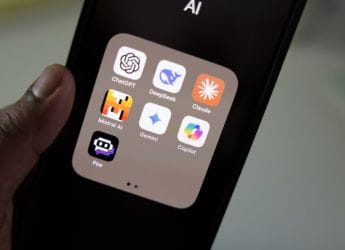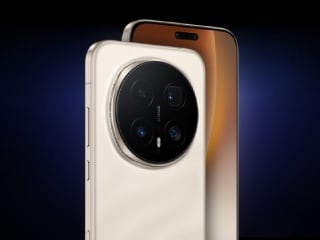- Home
- Mobiles
- Mobiles Reviews
- Motorola One Vision Review
Motorola One Vision Review
Does it have enough substance to beat the latest by Samsung, Xiaomi, and Realme?
Motorola One Vision comes in a single variant with 4GB of RAM paired with 128GB of internal storage
Motorola has carved out a solid reputation for itself in the mid-range segment with phones that offer a good balance of features and pure Android experience at reasonable prices. Now that competition is at an all-time high, and even big names like Samsung are reworking their strategy, Motorola is also stepping up its game. Motorola One Vision is the latest phone from the company and it aims to be more premium than the bread-and-butter Moto G-series. This new model ups the ante with a more modern design and upgraded camera hardware, while still retaining a competitive price.
The phone's hole-punch camera is a feature that is still usually seen only on high-end phones, while the 21:9 display is being touted as multimedia-friendly. The camera hardware also impressive on paper, and there are a host of photography features to play with. But how relevant are these features in the long run? More importantly, does the Motorola One Vision offer a good enough experience to justify its asking price of Rs. 19,999? Let's dive into the review and find out.
Motorola One Vision design
The Motorola One Vision debuts a new design language for Motorola phones, adopting a curved glass profile with prominent rounded edges and a gradient design. The phone is offered in a choice of two colours: Bronze Gradient and Sapphire Gradient. Both are darker in the middle of the rear panel, gradually fading into chocolate brown and bright blue, respectively.
On closer inspection, one can see thin lines running horizontally across the rear panel beneath the glossy layer. The Motorola One Vision's design is eye-catching, and more importantly, it will stand out in a sea of other phones that sport a gradient aesthetic.
The Android One logo at the bottom and the batwing Moto emblem embossed on the rear-mounted fingerprint sensor have a silvery finish that provides a nice contrast. The huge camera bump is an annoyance, and the rear panel is also quite smudge-prone.
Appealing design aside, the Motorola One Vision also feels comfortable in the hand. The curved glass rear panel blends almost seamlessly with the plastic rim running around the edges. Motorola says that this phone is IP52-rated and that it can handle accidental liquid splashes, thanks to an oleophobic coating.
The power button is located on the right and has ridges on it for easy identification. The volume rocker sits above it, but it is placed a little too high and we found it quite difficult to reach without adjusting the phone in our hand.
The Motorola One Vision is not the first phone in India with a hole-punch display. It can be seen on a number of phones including the Honor 20 (Review), Samsung Galaxy S10 (Review), Galaxy M40 (Review), and Nokia X71 However, the 21:9 aspect ratio is fairly unique, and we've only seen this on a handful of Sony phones, the Xperia 1 and Xperia 10, which have not been launched in India yet.
Motorola claims that the 21:9 aspect ratio is ideal for watching videos on platforms like Netflix and YouTube, since a large number of filmmakers preferer the 21:9 format. The company calls this CinemaVision display.
The phone's rear panel has an appealing gradient finish, but it is also prone to smudges
Media consumption aside, the tall aspect ratio introduces some advantages and drawbacks. The relatively narrow profile of the phone makes it a little more comfortable to hold than most. On the flip side, the elongated display means it becomes increasingly difficult to reach content at the top of the screen. We found that at least one-third of the screen's upper portion was beyond the reach of our thumbs, and required us to adjust the phone's position.
We also feel that Motorola has failed to fully capitalise on the hole punch. The top bezel and the chin are relatively thick compared to other phones that use creative camera placement to achieve a full-screen design. Secondly, the thick circular border around the front camera makes it look much bigger than it actually is, and it also eats up valuable screen space. Motorola had to make the status bar much thicker than usual to prevent the large punch hole from covering on-screen content.
The left side of the phone houses the hybrid dual-SIM (Nano) tray, which can accommodate a microSD card of up to 512GB at the expense of dual-SIM functionality. The USB Type-C port and speaker are located at the bottom, while a 3.5mm headphone jack can be found at the top.
Motorola One Vision specifications
The Motorola One Vision packs a 6.3-inch full-HD+ (1080 x 2520 pixels) IPS display with a density of 432ppi and 21:9 aspect ratio. It is protected by Corning Gorilla Glass 3.
This new Motorola phone is powered by Samsung's octa-core Exynos 9609 SoC clocked at 2.2GHz, which is basically a toned-down version of the Exynos 9610 that powers the Samsung Galaxy A50 (Review) and runs slightly faster at 2.3GHz. Both processors share the same architecture and have a lot in common when it comes to their capabilities. The choice of an Exynos processor is a little surprising, so we're interested to see how well this phone performs.
The Motorola One Vision display offers good sunlight legibility and viewing angles, but it is no match for an AMOLED panel
The Motorola One Vision packs 4GB of RAM and a generous 128GB of internal storage. The phone comes in just one configuration. It is equipped with a relatively small 3,500mAh battery, which can quickly be topped up by the included 15W TurboPower adapter.
The Motorola One Vision marks a major stride forward for Motorola in terms of camera specifications, as it packs a 48-megapixel f/1.7 camera. The primary sensor on the Motorola One Vision is the Samsung Isocell GM1, which utilises Quad Pixel technology — pixel binning, in common terms — for combining four pixels into a single large one to capture more light, resulting in brighter and more detailed photos.
The 48-megapixel primary camera is assisted by a 5-megapixel depth sensor. Thankfully, there is optical image stabilisation to compensate for hand movements, and its advantage is clearly reflected in the phone's video output. On the front is a 25-megapixel camera with an f/2.0 aperture sitting in the hole, which can also utilise pixel binning to deliver brighter selfies at a lower resolution.
There are a tonne of camera features to play with including portrait mode, Night Vision, live filters, and slo-mo video. Additionally, the ‘Spot Color' feature allows users to pick and highlight one particular colour in a frame and render the rest of the image in grayscale for artistic effect.
The Motorola One Vision runs stock Android and is a part of the Android One programme, which means guaranteed security updates for the next three years and two major OS upgrades after Android Pie. Our review unit ran Android Pie with the June security patch.
A bloatware-free UI without any spammy notifications and ads is the biggest benefit of stock Android, not to mention the no-frills, no-fuss clean design that a lot of users appreciate. The Motorola phone comes with just the basic apps and Google's suite of applications pre-installed.
The only additions from Motorola's side come in the form of the Moto app that provides access to Moto Actions and Moto Display, and the Moto Help app for support and troubleshooting. Moto Actions are Motorola's gestures, such as a double-wrist twist to open the camera app, a double-chop gesture to turn on the flashlight, and a three-finger tap to take a screenshot.
The curved rear panel and the slim profile of the Motorola One Vision pave the way for a comfortable grip
The Motorola One Vision introduces a new ‘One Button Nav' feature in Moto Actions, which appears to be an amalgam of iOS and Android Q's navigation gestures. A single tap on the elongated Home button takes you to the home screen, while an upward swipe opens the multitasking interface. A swipe to the left performs the back gesture, while swiping right switches to the previous app. This implementation of gesture-based navigation is smooth, but it sure takes some time to get used to.
Moreover, you get the usual set of Android Pie features such as Digital Wellbeing, Adaptive Brightness, and Adaptive Battery. Even though we like the clutter-free interface of stock Android, we also somewhat miss the features offered by custom skins and forks such as OxygenOS, One UI, EMUI, and MIUI.
Motorola One Vision display and performance
Before we talk about performance and benchmark figures, let's address the one aspect of this phone that instantly piques interest — the 21:9 display. The extra-wide aspect ratio is definitely a joy when watching native 21:9 videos in landscape mode. Also, you get more screen space while using two apps simultaneously in split view.
Even though the punch hole blocks a small part of the on-screen content, the experience of watching a movie or TV series is definitely better and more immersive than on a phone with a different aspect ratio, as long as the content in the 21:9 ratio. In addition to watching videos, we also liked the fact that we can see more content while browsing the Web.
![]() Motorola One Vision is offered in Bronze Gradient and Sapphire Gradient colour options
Motorola One Vision is offered in Bronze Gradient and Sapphire Gradient colour options
The Motorola One Vision's display is tailor-made for extra-wide cinematic viewing, and we quite enjoyed it. Motorola has made a strong case in favour of the 21:9 aspect ratio, stating that around 70 percent of Netflix originals are shot in the 21:9 format.
With that said, only limited content like Bird Box is actually in 21:9 aspect ratio, and you'll have to put with a huge black bar while watching other content, prompting one to wonder where exactly the "huge advantage" is. There are also some scaling issues with running games. For example, you can't really take advantage of the 21:9 display with the hole covering some on-screen buttons while gaming.
Not many games support the 21:9 aspect ratio, so you either have to live with a thick black bar that hides the hole punch or reposition the on-screen buttons if the game allows that. If not, the hole might be where some controls need to be.
In our case, we had to adjust the position of the brake button in Asphalt 9: Legends. Another thing we noticed is that there's a thin ring of light that shines between the actual selfie camera and its circular border. This is noticeable when looking at the punch hole up close, and that too, in dark surroundings.
As for the display quality itself, we found the full-HD+ IPS panel of the Motorola One Vision to be of decent quality. The viewing angles are good and sunlight legibility is also up to the mark. However, the raw colour output is a little off.
The display has a slightly bluish tinge to it and colours looked muted, especially when compared to an AMOLED panel. In a side-by-side comparison with the (much more expensive) Google Pixel 3 (Review), we found that the Motorola One Vision's screen renders slightly washed-out colours. Disappointingly, there is no way to adjust the screen's white balance.
![]() The Motorola One Vision is powered by the Samsung-made Exynos 9809 SoC clocked at 2.2 GHz
The Motorola One Vision is powered by the Samsung-made Exynos 9809 SoC clocked at 2.2 GHz
The phone does allow users to choose between three colour profiles — natural, boosted, and saturated. We found the ‘saturated' profile to be the best one as it enhances colours and makes on-screen content look more vibrant, but your mileage may vary.
The resolution is enough to render sharp content, but colours simply do not pop enough for us to label this phone particularly superior for multimedia consumption. At the end of the day, considering the emphasis laid by Motorola on glorifying the One Vision's display, we feel a little let down by its quality. The Samsung Galaxy A50 (Review), which is priced lower than the Motorola offering, packs a beautiful Super AMOLED display that is much better in terms of overall quality.
Now we come to the performance of the Motorola One Vision with its Samsung-made octa-core Exynos 9809 SoC clocked at 2.2 GHz. The choice of processor is unorthodox, not only because a majority of phones in this price bracket go with a Snapdragon 6xx or MediaTek P-series SoC, but also because the Motorola One Vision is the first phone to ship with it. Samsung itself has not launched a phone powered by the Exynos 9609 SoC yet.
When it comes to day-to-day performance, the Exynos 9609 proves to be a capable performer. We did not come across any lag or stutters in our daily usage, which involved heavy multitasking, Web browsing, etc. Even while playing games such as PUBG Mobile and Asphalt 9: Legends at high graphics settings, our experience was good.
The Exynos 9609's synthetic benchmark performance is comparable to that of the Snapdragon 660 and the MediaTek Helio P70, but it falls short of numbers posted by the Snapdragon 675.
Talking about benchmark scores, the Exynos 9609-powered Motorola One Vision posted an AnTuTu score of 145,565. The Geekbench 4 single-core and multi-core benchmark tallies stood at 1,603 and 5,403 respectively. The phone returned 1,321 points in 3DMark Slingshot Extreme, while the 3DMark Ice Storm Unlimited test returned 21,830 points.
To sum up the experience, the Motorola One Vision is not going to set any new benchmark records, but this phone won't leave you wanting for more power either. You can rest assured that it can handle any task you throw at it with ease, even graphics-intensive games.
The Motorola One Vision's display has a 21:9 aspect ratio and a large camera hole punch
Motorola One Vision cameras and battery life
Coming to camera performance, the Motorola One Vision‘s 48-megapixel rear camera captures some really beautiful photos with a tonne of detail and depth. The photos not only look good on the phone's screen, but they also appear vivid on a larger display.
Much like other phones, despite packing a 48-megapixel primary camera, the photos are taken at a default resolution of 12 megapixels after combining four adjacent pixels into a larger one with an effective 1.6-micron size to collect more light.
Unfortunately, you cannot take photos at the full 48-megapixel resolution, unlike on other phones such as the Redmi Note 7 Pro (Review) that employ the same technique. This might confuse or disappoint people who see the 48-megapixel rating as a selling point.
This aside, the pixel-binned 12-megapixel shots are detailed and have rich colours. A major gripe we have with photos captured in daylight is that they turned out to be a little oversaturated. If you are a fan of realistic colours with good dynamic range, the Motorola One Vision will disappoint you with its slightly overblown hues.
The phone takes daylight photos at a high exposure by default, and we often had to lower it manually using the slider on the screen to prevent colours from looking blown out. HDR helps a little, as it enhances colours and also boosts the sharpness. It must be noted that the Auto-HDR mode is enabled by default, but you can choose to activate or disable HDR manually for more control.
When it comes to macro shots, the Motorola One Vision's cameras deliver impressive results. Edge detection is good and the amount of surface detail preserved is also quite impressive. The only thing that keeps macro shots from being truly great is the overprocessing done by the camera, which tends to smoothen out minute details such as textures and gradients in order to make the colours pop.
![]()
![]()
![]()
![]()
![]() Tap to see full-sized Motorola One Vision camera samples
Tap to see full-sized Motorola One Vision camera samples
The camera occasionally struggled with locking focus while capturing macro shots, but this can be handled by adjusting the distance and angle of the camera. With long-range shots, the Motorola One Vision's camera did a good job at highlighting the object in focus, but the background and peripheral elements looked a little softer.
However, the phone makes up for that shortcoming in low-light scenarios. It excelled at capturing vivid shades of the sky in the evening, and demonstrated good control over dynamic range. The sharpness of photos taken in such scenarios is decent, but there is still a noticeable amount of noise in the background elements.
The most impressive aspect of the Motorola One Vision's imaging capabilities is the dedicated night mode, which the company calls Night Vision. To put it simply, the low-light results are among the best we've seen from a phone under the Rs. 20,000 mark.
The Night Vision mode does a good job of bringing out colours and resolving elements, while enhancing sharpness and preserving detail in a frame. For comparison sake, the Motorola One Vision's night mode performs better in low light than the Redmi Note 7 Pro.
The 25-megapixel selfie camera also does a good job, as the selfies are detailed and crisp. Portrait selfies exhibit a good bokeh effect and a healthy amount of detail. We preferred the pixel-binned shots captured at 6 megapixels over the native 25-megapixel ones because they turned out brighter and looked more vibrant. We quite liked the fact the Motorola One Vision performs minimal smoothening and whitening, preserving skin complexions and textures.
![]()
![]() Regular low-light image (top) and Night Vision mode (bottom) on the Motorola One Vision. Tap to see full-sized images
Regular low-light image (top) and Night Vision mode (bottom) on the Motorola One Vision. Tap to see full-sized images
As far as videos go, the rear cameras can record full-HD videos at 30fps or 60fps and 4K at 30fps. OIS helps to smoothen out hand movements and delivers smooth videos, but the camera struggles at capturing true colours and there is some focus hunting as well. Another weak area is audio, which often turned out shrill with a considerable amount of background noise.
The Motorola One Vision can record slo-mo videos at 240fps or 120fps. Slo-mo videos captured under natural light turned out smooth, but those recorded indoors exhibited a light flickering effect.
The Colour Pick feature works really well, letting us capture some beautiful photos by highlighting just one colour of our choice in the entire frame and rendering the rest in black and white. There are also a host of live scene filters and portrait lighting effects to play with. A Cut Out feature lets users substitute the original background of a photo with any other image in the gallery is also there.
The Motorola One Vision comes equipped with a 3,500mAh battery, which is smaller than what rivals have to offer. In our day-to-day usage — which involved music playback over wired headphones for a couple of hours, intermittent Web browsing and social media usage throughout the day, using productivity apps like Slack, a few calls, and around an hour of gaming — the phone barely managed to make it past a full day.
On average, we noticed that the phone had around 10 to 15 percent power left in the tank on reaching home at the end of the day. However, if you are into playing graphics-intensive games, expect the battery endurance to dip further. Thankfully, we did not encounter any heating issues while playing games or during intensive multi-tasking.
In our HD video battery loop test, the phone lasted for 11 hours and 45 minutes. As for charging speed, the bundled 15W Turbo Power adapter takes the phone from 0 to 100 percent in less than two hours.
Verdict
The Motorola One Vision stands out with its appealing design and 21:9 display with a hole punch, a combination that is not found on any other phone in the Indian market right now. Stock Android is a big plus for users who want a clean software experience without any bloatware.
Performance-wise, the Motorola One Vision proves to be a capable phone that can handle any task with ease. The camera output is also impressive, especially in the Night Vision mode, which offers the best low-light results of any phone in this price bracket.
However, the implementation of the hole punch design and the underwhelming display quality don't bode well for the Motorola One Vision. The battery life of the phone is not too good either.
If you want a better display, more cameras, and an in-display fingerprint sensor, the Samsung Galaxy A50 (Review) is worth checking out. But if you are smitten by the hole-punch design, the freshly launched Galaxy M40 (Review) is a solid alternative with its triple rear cameras and the more powerful Snapdragon 675 processor.
At a slightly lower price, you could also get your hands on a previous-gen mid-range flagship such as the Poco F1 (Review), which offers a lot more power. Further going down the price segment, the Realme 3 Pro (Review) and Redmi Note 7 Pro (Review) offer great value for money in our list of the best phones under Rs. 20,000.
On its own, the Motorola One Vision has its fair share of positives and negatives, but more importantly, it has a unique personality that is hard to find elsewhere in its price bracket. Needless to say, this phone should definitely be on your list if you are looking for a phone in the sub-Rs. 20,000 segment.
Get your daily dose of tech news, reviews, and insights, in under 80 characters on Gadgets 360 Turbo. Connect with fellow tech lovers on our Forum. Follow us on X, Facebook, WhatsApp, Threads and Google News for instant updates. Catch all the action on our YouTube channel.
Related Stories
- Samsung Galaxy Unpacked 2025
- ChatGPT
- Redmi Note 14 Pro+
- iPhone 16
- Apple Vision Pro
- Oneplus 12
- OnePlus Nord CE 3 Lite 5G
- iPhone 13
- Xiaomi 14 Pro
- Oppo Find N3
- Tecno Spark Go (2023)
- Realme V30
- Best Phones Under 25000
- Samsung Galaxy S24 Series
- Cryptocurrency
- iQoo 12
- Samsung Galaxy S24 Ultra
- Giottus
- Samsung Galaxy Z Flip 5
- Apple 'Scary Fast'
- Housefull 5
- GoPro Hero 12 Black Review
- Invincible Season 2
- JioGlass
- HD Ready TV
- Laptop Under 50000
- Smartwatch Under 10000
- Latest Mobile Phones
- Compare Phones
- Honor Win RT
- Honor Win
- Xiaomi 17 Ultra Leica Edition
- Xiaomi 17 Ultra
- Huawei Nova 15
- Huawei Nova 15 Pro
- Huawei Nova 15 Ultra
- OnePlus 15R
- Asus ProArt P16
- MacBook Pro 14-inch (M5, 2025)
- OPPO Pad Air 5
- Huawei MatePad 11.5 (2026)
- Xiaomi Watch 5
- Huawei Watch 10th Anniversary Edition
- Acerpure Nitro Z Series 100-inch QLED TV
- Samsung 43 Inch LED Ultra HD (4K) Smart TV (UA43UE81AFULXL)
- Asus ROG Ally
- Nintendo Switch Lite
- Haier 1.6 Ton 5 Star Inverter Split AC (HSU19G-MZAID5BN-INV)
- Haier 1.6 Ton 5 Star Inverter Split AC (HSU19G-MZAIM5BN-INV)


















